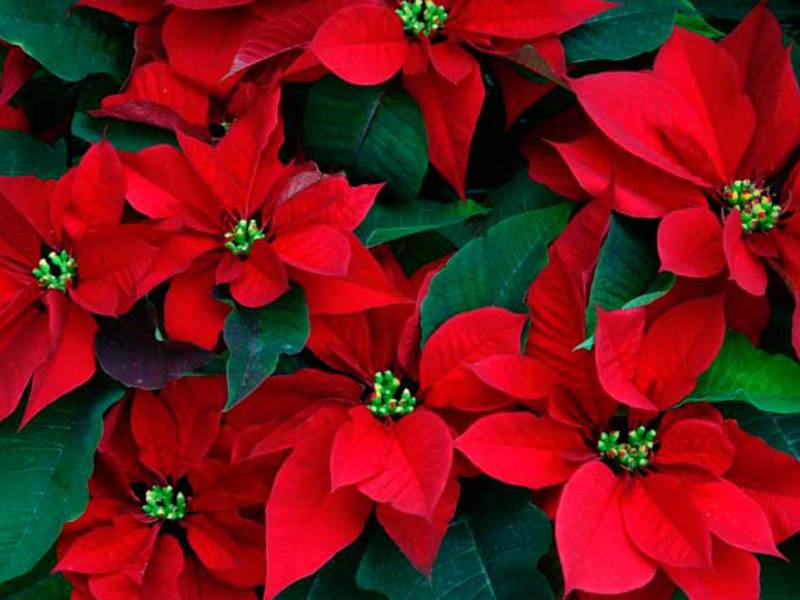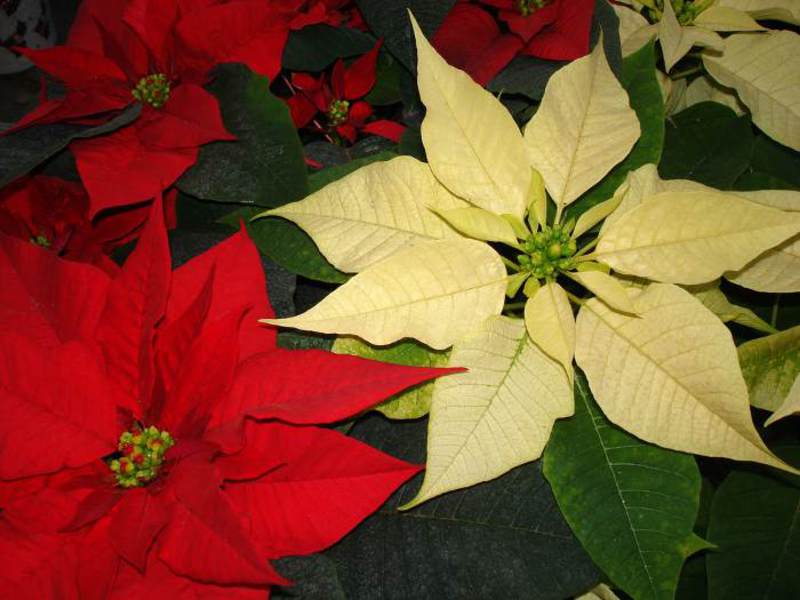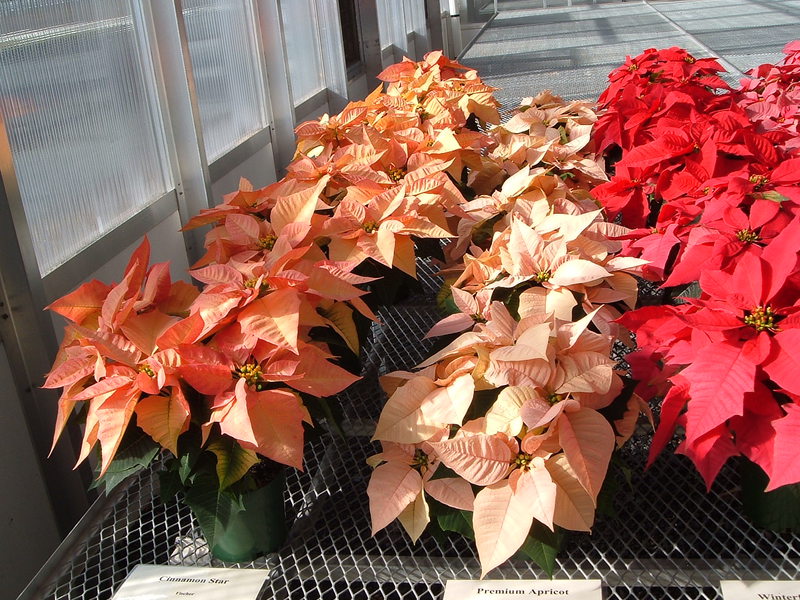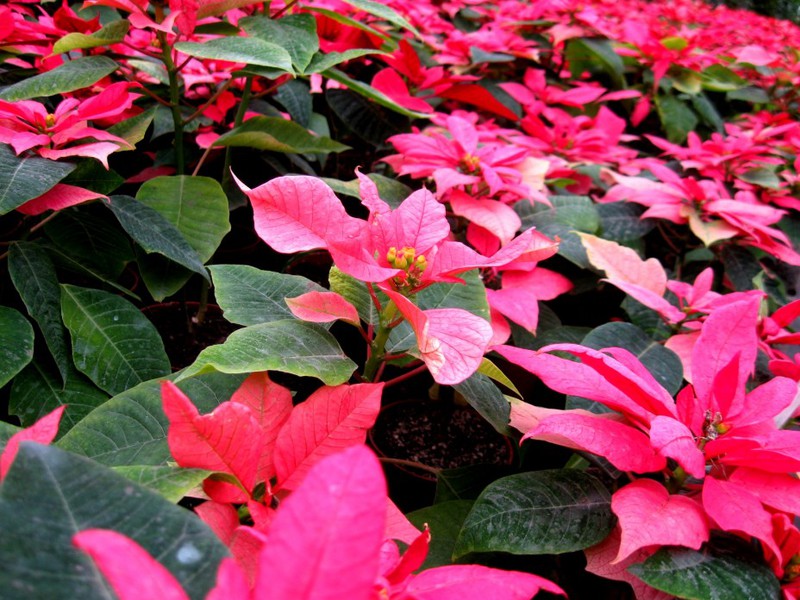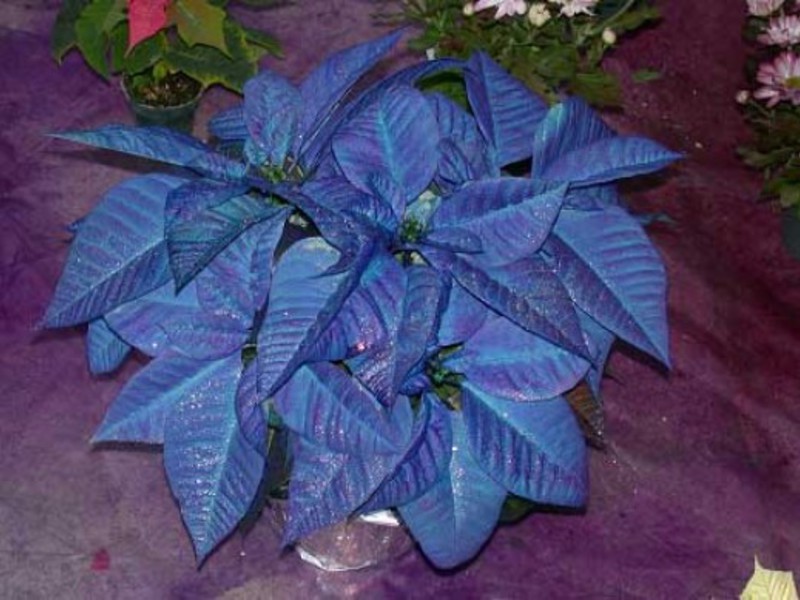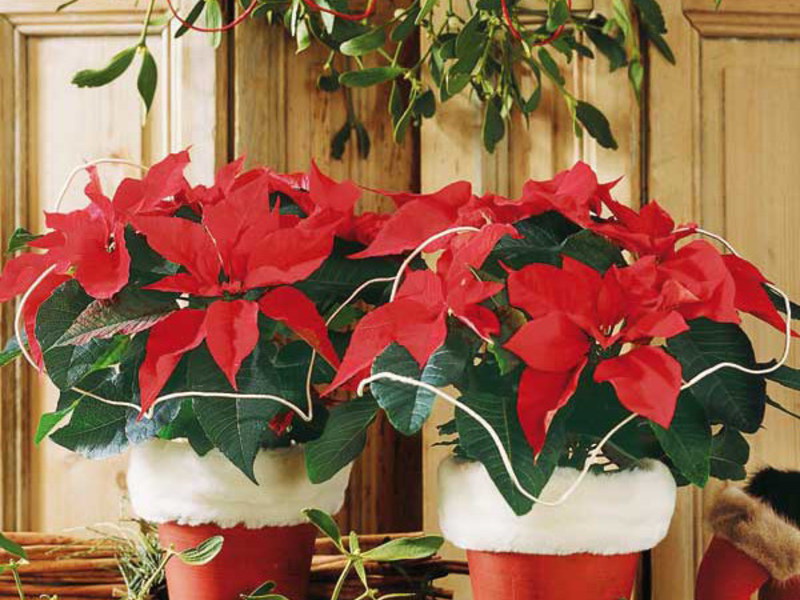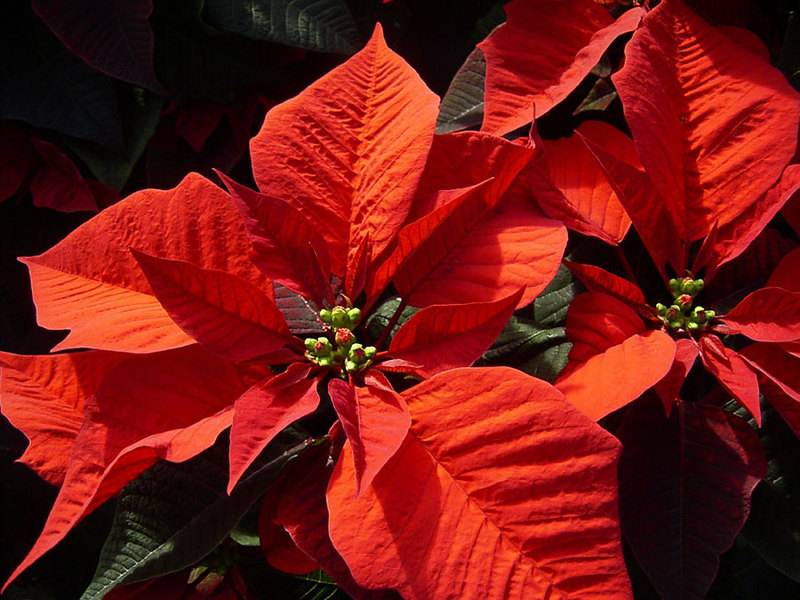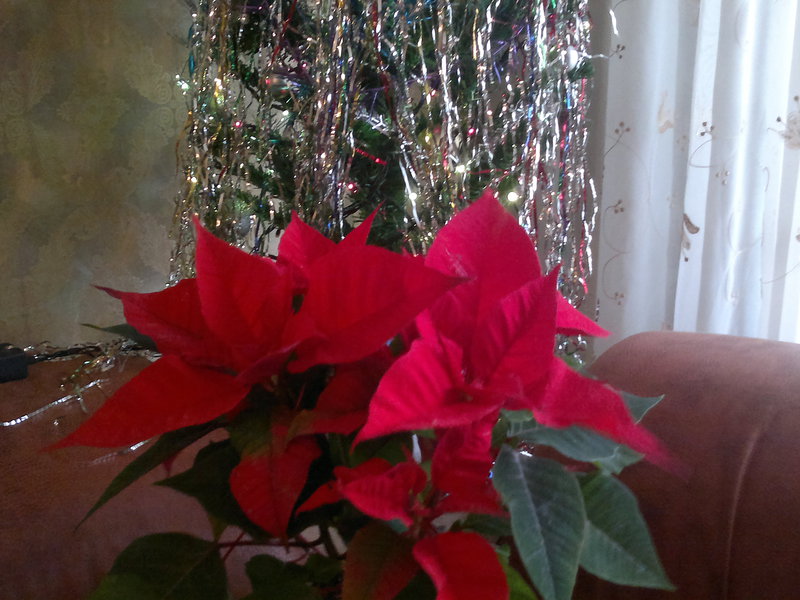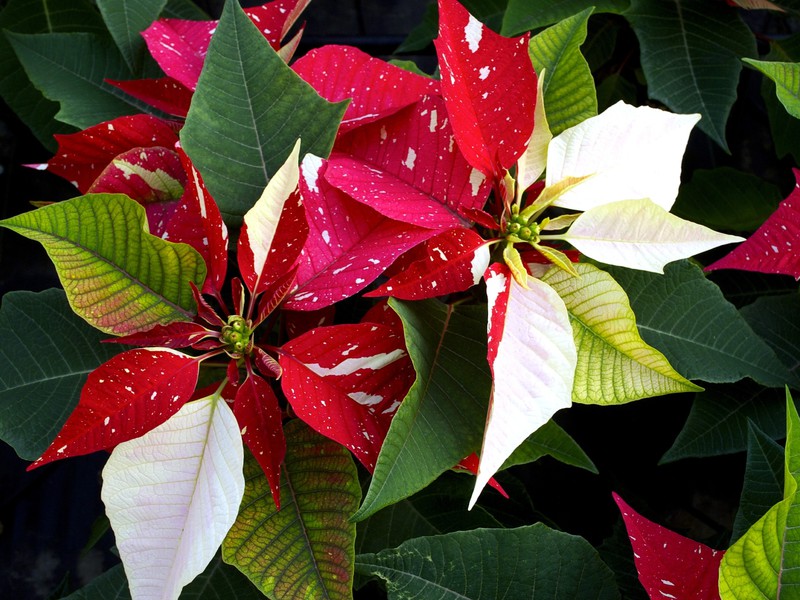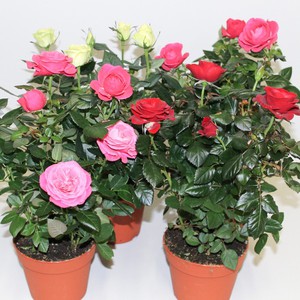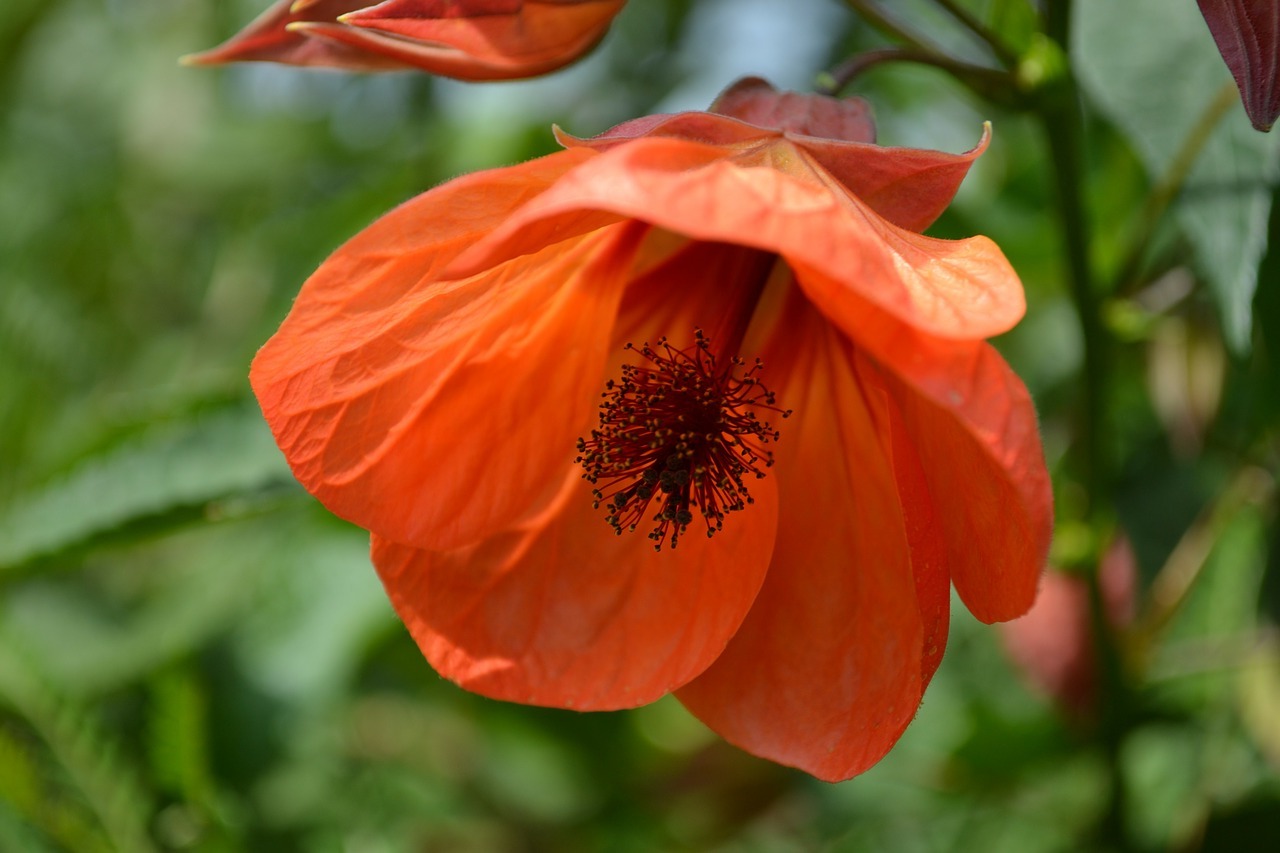Among the evergreen shrubs, there are many noteworthy plants. This is the poinsettia, which represents the euphorbia family. Its name sounds very unusual - translated from Latin it means "the most beautiful euphorbia". He also has an unofficial name - the Christmas star. This plant was first discovered in Mexico and Central America.
Considering that poinsettia grows in tropical conditions, it has a rather impressive height, which is three meters... The specimens grown in indoor conditions look more modest - they do not exceed 40 cm in height. The plants have elliptical leaves with jagged edges of a dark green color.
As for poinsettia flowers, they look like compact yellow rosettes. Red bracts are located around them. In recent years, breeders have been able to develop new varieties of the most beautiful milkweed, so today it is not uncommon to find plants in the store that have yellow, pink, white, two-colored bracts.
However, when growing poinsettia at home, you should take into account certain nuances and recommendations, following which you can achieve abundant flowering of the most beautiful poinsettia.
Content
How to care for a poinsettia indoor flower
A photo of a plant easily attracts attention. But not only the flower itself is unusual, but also its name. It is quite simple to explain it, because the plant starts to bloom at Christmas, so he was given the name "Christmas Star". However, by the time of the end of flowering, the plant loses not only inflorescences, but also leaves, at this stage of its development there is a risk of its complete death. However, it is in the power of every grower to preserve this beautiful plant, for which you just need to remember some points regarding its cultivation:
 at the first signs of leaf falling, you need to abandon watering and dressing. It is imperative to prune the stems at a height of 15 cm from the ground level. Then the plant is transferred to a dark place, where it should be until the end of spring;
at the first signs of leaf falling, you need to abandon watering and dressing. It is imperative to prune the stems at a height of 15 cm from the ground level. Then the plant is transferred to a dark place, where it should be until the end of spring;- at the end of spring, the poinsettia must be returned to a sunny place, where from this moment they begin to carry out abundant watering and fertilizing;
- at the first signs of growth, the most beautiful milkweed is transplanted into new soil;
- An effective measure that stimulates the bud formation process is to place the plant in a dark place from October, or instead, it is covered with a box. A similar operation with a poinsettia must be carried out at least up to 14 hours a day;
- noticing that the bracts have already formed, you can stop keeping the flower in a dark place. From this point on, you need to provide it with regular watering.
Great attention should be paid to the perfect poinsettia while highlighting them juice, which is very poisonous... Any contact with it can be dangerous to health: if the juice gets on the skin, it can cause allergic reactions, when it interacts with the eyes, blindness can occur, with the oral cavity - gag reflexes. To prevent such negative phenomena, it is recommended that all activities for the care of the poinsettia be carried out in rubber gloves.
Suitable temperature for growing a poinsettia plant
This plant will hurt less and bloom longer if it grow in favorable temperature conditions... To do this, consider the following points:
- the most favorable for the poinsettia flower is the temperature regime from 18 to 25 degrees Celsius;
- at the moment the flowers begin to form, it is recommended to reduce the temperature to 14-16 degrees;
- in the cold season, when the poinsettia is at rest, it is advisable to maintain the temperature in the room not higher than 14 degrees Celsius;
- it is recommended to grow poinsettia in a quiet place that must be protected from drafts.
Lighting
The poinsettia feels most comfortable if it grow on the windowsill... There should be good lighting, but direct sunlight should be avoided. Failure to comply with this recommendation can lead to negative changes: very soon the leaves will turn brown and begin to fall off.
Watering a poinsettia indoor plant
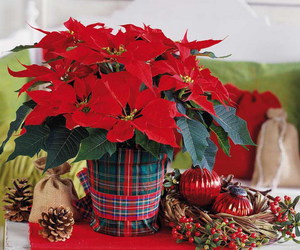 In winter, the flower is watered as needed: you can determine the moment by how the soil begins to dry out completely. It is quite different to look after in the summer, when irrigation is carried out every day in small quantities.
In winter, the flower is watered as needed: you can determine the moment by how the soil begins to dry out completely. It is quite different to look after in the summer, when irrigation is carried out every day in small quantities.
At the flowering stage, it is useful to supplement irrigation with spraying, which is carried out every three to four days. For this purpose, use slightly warm water, which should be infused for at least 1 day.
If you follow these simple watering rules, you no longer have to watch the poinsettia drop its attractive leaves.
Top dressing
Fertilizers are applied to the soil under the poinsettia twice a month. The first feeding is carried out in the spring, and the last one - in the fall. Recommended for this purpose apply mineral fertilizers... When the most beautiful euphorbia begins to bloom, fertilizers rich in potassium are used. But on this score, there is an opinion that poinsettia may well do without feeding. It is believed that the highest quality flowers are obtained only when no special measures are taken with respect to plants at this stage of the life cycle.
Potted flower transplant poinsettia
When the Christmas star comes out of its dormant state, which usually occurs in late April or early May, it can be transplanted. This can be determined by the beginning of the formation of green leaves on the stems. In preparation for planting a beautiful poinsettia, the bottom of the pot must be filled with a drainage layer. Attention should also be paid to the soil, which must have a non-acidic reaction.
For the preparation of planting soil, leafy soil, peat, clay-turf, and sand are used. All of these components are taken in a ratio of 2: 1: 3: 1.
It is possible to increase the chances of a poinsettia for survival in a new place and make it more resistant to disease if you exercise the utmost care when transplanting into a new pot. It is very important here to make sure that the maximum amount of old soil remains on the roots. Otherwise, the care is carried out according to the usual scheme.
How to prune a poinsettia flower?
 Home care provides for trimming, which is carried out at the time of yellowing of the leaves, the stems are removed to a level of 15 cm from the soil level. It is necessary to carry out this procedure again at the end of the transplant, when new shoots begin to form. This operation ensures the maximum attractiveness of the plant and the correct shape.The positive effect of pruning a Christmas star is that the plant will bloom more than once in the future.
Home care provides for trimming, which is carried out at the time of yellowing of the leaves, the stems are removed to a level of 15 cm from the soil level. It is necessary to carry out this procedure again at the end of the transplant, when new shoots begin to form. This operation ensures the maximum attractiveness of the plant and the correct shape.The positive effect of pruning a Christmas star is that the plant will bloom more than once in the future.
It is also possible to find useful use for weak, pruned shoots, which can serve as planting material for reproduction.
Dormant period
This stage can be determined by the formation of leaves in the poinsettia. This is most often observed in early April. In this case, the plant must be moved to a dark, cool place, where it should be until early May.
Reproduction of poinsettia at home
The sowing method is not suitable for producing new poinsettia plants at home. Therefore, only one option is possible here - reproduction using cuttings. To do this, you will have to prepare shoots at the end of spring. The cuttings to be cut should be no more than 70 cm in length. 4 or 6 large kidneys.
Also, in relation to the cuttings, an operation is performed to remove the poisonous juice. For this purpose, they need to be placed in warm water, keeping in it for 25-35 minutes. Finally, a special agent is applied to the cut, which accelerates the formation of roots. For planting, containers are prepared filled with soil, for the preparation of which the following components are used:
- sand;
- dry manure;
- humus.
Particular attention should be paid to the fact that the soil should keep wet... After planting the cuttings, the container must be transferred to a bright place, stretch a film over it and maintain a temperature of 24-28 degrees Celsius in the room. It is very important to prevent the soil from becoming moldy. For this purpose, it is necessary to regularly ventilate, slightly opening the protective film. Watering is carried out every three to four days. This can be done in the usual way or by spraying using a spray bottle.
When a month has passed since the cuttings are completely rooted, the polyethylene can be removed and the temperature lowered to 16 degrees Celsius. With the onset of autumn, young plants are transplanted into pots with a diameter of 20 cm. Usually, with proper care, seedlings enter the flowering phase after a year.
Diseases and pests
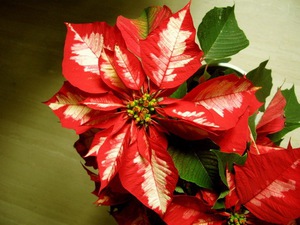 At the Christmas star there are many pestsfrom which she could be seriously hurt. This list can include scale insects, mealybugs, thrips, whiteflies, and spider mites. Often during illness, you can see the leaves become covered with a white mass, similar to wax. They may also have whitish, unpleasant spots.
At the Christmas star there are many pestsfrom which she could be seriously hurt. This list can include scale insects, mealybugs, thrips, whiteflies, and spider mites. Often during illness, you can see the leaves become covered with a white mass, similar to wax. They may also have whitish, unpleasant spots.
For pest control, it can be used along with chemical compositions and folk remedies... Of the latter, the following can be proposed:
- soap solution shows good results in the fight against scale insects and aphids. To do this, they need to regularly process the infected leaves once a week. After each rubbing, the plants must be rinsed with clean water;
- mineral oil can be used to fight worms.
However, it is not always possible to cope with the problem with the help of folk remedies. In this case, it makes sense to consider the option of buying special protective equipment in order to start fighting the disease in a timely manner and avoid yellowing of the poinsettia.
Enough dangerous diseases for plants are the following:
- Gray rot. Favorable conditions for its appearance arise with abundant watering and high air humidity. It can be identified by gray, fungal bloom on the stems and brown spots on the leaves. To combat it, you can use the drugs "Skor", "Celandine" and "Fundazol";
- Fusarium. This disease is dangerous because it can provoke the complete death of shoots;
- Mealy rot. When it appears on the flowers, you can notice a characteristic bloom of white. This disease usually leads to the death of the plant. It is possible to cope with it with the help of Topaz and Fitosporin-M preparations.
- Often, when grown in indoor conditions, the leaves begin to turn yellow at the poinsettia. The most likely reasons for this are too much watering and cool growing conditions. These factors provoke root rot, to which the leaves that change their color are the first to react. However, this may also be due to very poor watering. In this case, the most beautiful euphorbia can attract a tick, as a result of which the leaves begin to turn yellow.
Conclusion
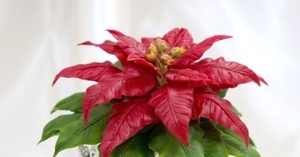 Even taking into account the fact that poinsettia is a tropical plant, and at home in our latitudes can be grown successfully... This plant is highly decorative, as demonstrated by its leaves and flowers. However, you can enjoy this beauty only if you follow the rules of caring for it.
Even taking into account the fact that poinsettia is a tropical plant, and at home in our latitudes can be grown successfully... This plant is highly decorative, as demonstrated by its leaves and flowers. However, you can enjoy this beauty only if you follow the rules of caring for it.
Particular attention should be paid to the temperature regime, remembering that the tropics are its natural habitat. Therefore, at each stage of plant development, a certain temperature must be maintained. It is equally important during poinsettia care and watering. Moreover, it alone may not be enough. Therefore, in addition to it, spraying is recommended, which will help maintain an optimal level of humidity.
